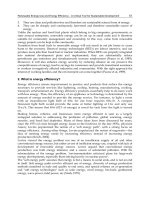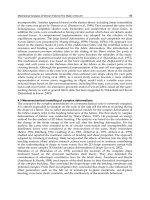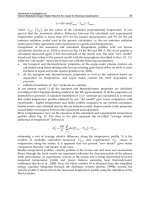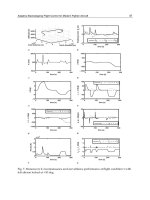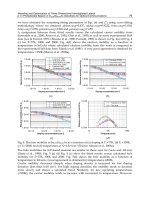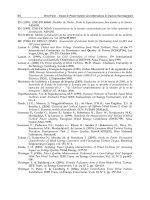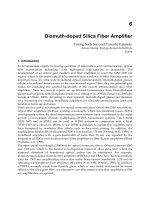- Trang chủ >>
- Khoa Học Tự Nhiên >>
- Vật lý
The Lecture Notes in Physics Part 4 potx
Bạn đang xem bản rút gọn của tài liệu. Xem và tải ngay bản đầy đủ của tài liệu tại đây (654.68 KB, 21 trang )
2 Stability of Quasi Two-Dimensional Vortices 53
such as the pairing of same sign vortices or the creation of vorticity filaments. They
should therefore modify the phenomenology of the turbulence. In particular for large
Rossby number and small Froude number, the pairing of two vortices is unstable to
the generalized zigzag instability and, while approaching each other the vortices
should form thinner and thinner layers resulting in an energy transfer to smaller
length scales and not larger scales as in the 2D turbulence. This effect of the zigzag
instability would then explain the result of Lindborg [32] who shows, processing
turbulence data collected during airplane flights and computing third-order moment
of the turbulence, that the energy cascade in the horizontal energy spectra is direct
and not reverse as it was conjectured by Lilly [31].
2.7 Appendix: Local Approach Along Trajectories
In this appendix, we investigate the instability of a 2D steady basic flow character-
ized by a velocity U
B
and a pressure P
B
in the inviscid case. The normal vector of
the flow field is denoted e
z
. The 3D perturbations are denoted (u, p). In a frame,
rotating at the angular frequency = e
z
, the linearized Euler equation read as
∂u
∂t
+ u.∇U
B
+ U
B
∇u =−∇p − 2 × u, (2.26)
∇.u = 0. (2.27)
Following Lifschitz and Hameiri [33], we consider a rapidly oscillating localized
perturbation:
u = exp
{
iφ(x, t)/ξ
}
a(t) + O(δ), (2.28)
p = exp
{
iφ(x, t)/ξ
}
(π(t) + O(δ)), (2.29)
where ξ is a small parameter. Substitution in the linearized Euler equations leads
to a set of differential equations for the amplitude and the wave vector k =∇φ
evolving along the trajectories of the basic flow:
dx
dt
= U
B
, (2.30)
dk
dt
=−L
T
B
k, (2.31)
da
dt
=
2kk
T
|k|
2
− I
L
B
a +
kk
T
|k|
2
− I
Ca, (2.32)
with L
B
=∇U
B
the velocity gradient tensor, the superscript T denoting the trans-
position, I the unity tensor, and C the Coriolis tensor:
54 J M. Chomaz et al.
C =
⎛
⎝
0 −2 0
2 00
000
⎞
⎠
. (2.33)
The pressure has been eliminated by applying the operator:
P(k) =
I −
kk
T
|k|
2
. (2.34)
The incompressibility equation (2.27) yields
k.a = 0. (2.35)
The stability is analyzed looking for the behavior of the velocity amplitude a.Fol-
lowing Lifschitz and Hameiri [33], the flow is unstable if there exists a trajectory on
which the amplitude a is unbounded at large time.
2.7.1 Centrifugal Instability
For flows with closed streamlines, centrifugal instability can be understood by con-
sidering spanwise perturbations, as they have been shown to be the most unsta-
ble in centrifugal instability studies (see [2] or [48] for a detailed discussion). If
k(t = 0) = k
0
e
z
, (2.31) yields k(t) = k
0
e
z
; the base flow, evolving in a plane
perpendicular to e
z
, does not impose tilting or stretching along z direction. The
incompressibility equation (2.35) gives a
z
= 0.
In the plane of the steady base flow, the trajectories (streamlines in the steady
case) may be referred to as streamline function value ψ. The two vectors, U
B
and
∇ψ, provide an orthogonal basis. The amplitude equation in the plane perpendicular
to e
z
may be expressed in this new coordinate system, and following [48], (2.32)
becomes
d
dt
a.U
B
a.∇ψ
=
0 ζ + 2
−2(
V
R
+ ) 2V
/V
a.U
B
a.∇ψ
, (2.36)
with V =|U
B
(x)|, V
the lagrangian derivative
d
dt
V = U
B
.∇V and R the local
algebraic curvature radius defined by [48]
R(x, y) =
V
3
∇ψ.
(
U
B
.∇U
B
)
. (2.37)
Note that the generalized Rayleigh discriminant, δ = 2
V
R
+
(
ζ + 2
)
, appears
in (2.36) as the opposite of the determinant of the governing matrix. Sipp and
Jacquin [48] showed that if there exists a particular streamline on which δ<0, the
velocity amplitude, a, is unbounded at large time. However, the general proof for
2 Stability of Quasi Two-Dimensional Vortices 55
the existence of diverging solutions of (2.36) for a closed (non-circular) streamline
with δ negative requires further mathematical analyses.
2.7.2 Hyperbolic Instability
In this section, we focus again on a spanwise perturbation characterized by a
wavenumber k perpendicular to the flow field. The contribution of the pressure
disappears in that case and the instability is called pressureless. Equation (2.32)
reduces to
da
dt
=−L
B
a − Ca. (2.38)
We look for instability of a basic flow characterized by
L
B
=
⎛
⎝
0 −
ζ
2
0
+
ζ
2
00
000
⎞
⎠
, (2.39)
with the local strain and ζ the vorticity of the base flow. For || greater than
|
ζ
2
| the streamlines are hyperbolic. The integration of (2.38) is straightforward. The
perturbed velocity amplitude a has an exponential behavior, exp(σ t), with σ
σ =
2
− (ζ /2 +2)
2
, (2.40)
as discussed in Sect. 2.3.2.
2.7.3 Elliptic Instability
The basic flow is defined by the constant gradient velocity tensor (2.39) but with
|
ζ
2
| greater than ||. Trajectories are found to be elliptical with an aspect ratio or
eccentricity:
E =
ζ
2
−
ζ
2
+
. (2.41)
Along those closed trajectories, (2.31) has period
T =
2π
Q
=
2π
ζ
2
2
−
2
. (2.42)
56 J M. Chomaz et al.
The wave vector solution of (2.31),
k = k
0
(
sin(θ) cos(Q(t −t
0
)), E sin(θ) sin(Q(t − t
0
)), cos(θ)
)
, (2.43)
with k
0
and t
0
integration constants, is easily obtained (see, for example, Bayly [3]).
The wave vector describes an ellipse parallel to the (x, y) plane, with the same
eccentricity as the trajectories ellipse, but with the major and minor axes reversed.
The stability is investigated with Floquet theory, looking for the eigenvalues of the
monodromy matrix M(T), which is a solution of
dM
dt
=
2kk
T
|k|
2
− I
L
B
M +
kk
T
|k|
2
− I
CM, (2.44)
with M(0) = I, (2.45)
integrated over one period T . The basic flow lies in the (x, y) plane, so that one
of the eigenvalues of the monodromy matrix is m
3
= 1. The average of the trace
of the matrix
2kk
T
|k|
2
− I
L
B
+
kk
T
|k|
2
− I
C is zero, making the determinant of
M(T ) equal to unity. The two other eigenvalues of M(T) are then m
1
m
2
= 1,
with m
1,2
either complex conjugate indicating stable flow, or real and inverse for
unstable flow. Generally, m
1,2
are obtained by numerical integration of (2.44) and
(2.45). Note, however, that the following two cases may be tackled analytically.
2.7.4 Pressureless Instability
In the case of a pressureless instability the monodromy equation is a solution of
dM
dt
=−L
B
M − CM (2.46)
M(0) = I. (2.47)
The eigenvalues of the monodromy equation are
m
i
= exp
±
2
− (ζ /2 +2)
2
T
, with i = 1, 2. (2.48)
With rotation, the elliptical flow may be unstable to pressureless instabilities, as
discussed in Sects. 2.3.1 and 2.3.2 and in Craik [15].
2.7.5 Small Strain |<<1|
Following Waleffe [50], we derive from (2.32) the equation for the rescaled compo-
nent of the velocity along the z-axis denoted q:
2 Stability of Quasi Two-Dimensional Vortices 57
q = a
3
|k|
2
|k
//
|
2
, (2.49)
with k
//
the component of the wavenumber on the (x, y) plane. For small strain,
this equation leads to a Mathieu equation with a rescaled time, t
= ζt,
d
2
q
dt
2
+
α +2bsin t
q = 0, (2.50)
where
α =
Ro + 1
Ro
2
cos
2
θ, (2.51)
Ro =
ζ
2
is the Rossby number and
b =
1
2
Ro + 1
Ro
2
sin
2
θ +
1
Ro
+
3
2
cos
2
θ. (2.52)
Parametric resonances occur when
α =
1
4
j
2
, (2.53)
with j an integer, giving the formula (2.14) discussed in Sect. 2.3.1.
References
1. Armi, L., Hebert, D., Oakey, N., Price, J., Richardson, P.L., Rossby, T., Ruddick, B.: The
history and decay of a Mediterranean salt lens. Nature, 333, 649 (1988). 35
2. Bayly, B.J.: Three-dimensional centrifugal-type instabilities in inviscid two-dimensional
flows. Phys. Fluids 31, 56 (1988). 38, 43, 54
3. Bayly, B.J.: Three-dimensional instability of elliptical flow. Phys. Rev. Lett. 57, 2160 (1986). 44, 45, 56
4. Billant, P., Chomaz, J M.: Experimental evidence for a new instability of a vertical columnar
vortex pair in a strongly stratified fluid. J. Fluid Mech. 418, 167 (2000). 47, 50, 52
5. Billant, P., Chomaz, J M.: Theoretical analysis of the zigzag instability of a vertical columnar
vortex pair in a strongly stratified fluid. J. Fluid Mech. 419, 29 (2000). 48
6. Billant, P., Chomaz, J M.: Three-dimensional stability of a vertical columnar vortex pair in a
stratified fluid. J. Fluid Mech. 419, 65 (2000). 48
7. Billant, P., Colette, A., Chomaz, J M.: Instabilities of anticyclonic vortices in a stratified
rotating fluid. Bull. Am. Phys. Soc. 47(10), 162. In: Proceedings of the 55th Meeting of the
APS Division of Fluid Dynamics, Dallas, 24–26 Nov 2002. 40
8. Billant, P., Colette, A., Chomaz, J M.: Instabilities of a vortex pair in a stratified and rotat-
ing fluid. In: Proceedings of the 21st International Congress of the International Union of
Theoretical and Applied Mechanics, Varsovie, 16–20 Aug 2004. 50, 51, 52
9. Billant, P., Gallaire, F.: Generalized Rayleigh criterion for non-axisymmetric centrifugal
instabilities. J. Fluid Mech. 542, 365–379 (2005). 39, 40
58 J M. Chomaz et al.
10. Cambon, C.: Turbulence and vortex structures in rotating and stratified flows. Eur. J. Mech.
BFluids20, 489 (2001). 44
11. Carton, X., McWilliams, J.: Barotropic and baroclinic instabilities of axisymmetric vortices
in a quasi-geostrophic model. In: Nihoul, J., Jamart, B. (eds.) Mesoscale/Synoptic Coherent
Structures in Geophysical Turbulence, p. 225. Elsevier, Amsterdam (1989). 37, 40
12. Caulfield, C.P., Kerswell, R.R.: The nonlinear development of three-dimensional disturbances
at hyperbolic stagnation points: a model of the braid region in mixing layers. Phys. Fluids 12,
1032 (2000). 47
13. Chomaz, J M., Rabaud, M., Basdevant, C., Couder, Y.: Experimental and numerical investi-
gation of a forced circular shear layer. J. Fluid Mech. 187, 115 (1988). 37
14. Colette, A., Billant, P., Beaudoin, B., Boulay, J.C., Lassus-Pigat, S., Niclot, C., Schaffner,
H., Chomaz, J M.: Instabilities of a vertical columnar vortex pair in a strongly stratified and
rotating fluid. Bull. Am. Phys. Soc. 45(9), 175. In: Proceeding of the 53rd Meeting of the
APS Division of Fluid Dynamics, Washington, 19–21 Nov 2000. 50, 51, 52
15. Craik, A.D.D.: The stability of unbounded two- and three-dimensional flows subject to body
forces: some exact solutions J. Fluid Mech. 198, 275 (1989). 45, 56
16. Dritschel, D.G., Torre Juárez, M.: The instability and breakdown of tall columnar vortices in
a quasi-geostrophic fluid. J. Fluid Mech. 328, 129 (1996). 50
17. Eckhoff, K.S.: A note on the instability of columnar vortices. J. Fluid Mech. 145, 417 (1984). 43
18. Eckhoff, K.S., Storesletten, L.: A note on the stability of steady inviscid helical gas flows.
J. Fluid Mech. 89, 401 (1978). 43
19. Fontane, J.: Etude expérimentale des instabilités 3-D d’une paire de tourbillons en milieu
tournant. Master thesis, CNRM, LadHyX, École Polytechnique. DEA Dynamique des Flu-
ides, Toulouse. (2002). 39
20. Kerswell, R.: Elliptical instability. Annu. Rev. Fluid Mech. 34, 83 (2002). 44, 45
21. Kloosterziel, R., Van Heijst, G.: An experimental study of unstable barotropic vortices in a
rotating fluid. J. Fluid. Mech. 223, 1 (1991). 38
22. Lacaze, L., Ryan, K., Le Dizès, S.: Elliptic instability in a strained Batchelor vortex. J. Fluid.
Mech. 577, 341–361 (2007). 46
23. Leblanc, S.: Internal wave resonances in strain flows. J. Fluid. Mech. 477, 259 (2003). 44
24. Leblanc, S., Cambon, C.: On the three-dimensional instabilities of plane flows subjected to
Coriolis force. Phys. Fluids 9, 1307 (1997). 47
25. Leblanc, S., Le Duc, A.: The unstable spectrum of swirling gas flows. J. Fluid Mech. 537,
433–442 (2005). 43
26. Le Dizès, S.: Inviscid waves on a Lamb–Oseen vortex in a rotating stratified fluid: conse-
quences for the elliptic instability. J. Fluid Mech. 597, 283 (2008). 45
27. Le Dizès, S., Eloy, C.: Short-wavelength instability of a vortex in a multipolar strain field.
Phys. Fluids 11, 500 (1999). 46
28. Leibovich, S., Stewartson, K.: A sufficient condition for the instability of columnar vortices.
J. Fluid Mech. 126, 335–356 (1983). 41, 42, 43
29. Ludwieg, H.: Stabilität der Strömung in einem zylindrischen Ringraum. Z. Flugwiss. 8,
135–142 (1960). 41, 42, 43
30. Eloy, C., Le Dizès, S.: Three-dimensional instability of Burgers and Lamb–Oseen vortices in
a strain field. J. Fluid Mech. 378, 145 (1999). 46
31. Lilly, D.K.: Stratified turbulence and the mesoscale variability of the atmosphere. J. Atmos.
Sci. 40, 749 (1983). 47, 48, 53
32. Lindborg, E.: Can the atmosphere kinetic energy spectrum be explained by two-dimensional
turbulence? J. Fluid Mech. 388, 259 (1999). 53
33. Lifschitz, A., Hameiri, E.: Local stability conditions in fluid dynamics. Phys. Fluids. 3, 2644
(1991). 44, 53, 54
34. Miyazaki, T.: Elliptical instability in a stably stratified rotating fluid. Phys. Fluids 5, 2702
(1993). 44, 45
35. Moore, D.W., Saffman, P.G.: The instability of a straight vortex filament in a strain field. Proc.
R. Soc. Lond. A 346, 413 (1975). 44
2 Stability of Quasi Two-Dimensional Vortices 59
36. Orlandi, P., Carnevale, G.: Evolution of isolated vortices in a rotating fluid of finite depth.
J. Fluid Mech. 381, 239 (1999). 37
37. Otheguy, P., Chomaz, J.M., Billant, P.: Elliptic and zigzag instabilities on co-rotating vertical
vortices in a stratified fluid. J. Fluid Mech. 553, 253 (2006). 49
38. Otheguy, P., Billant, P., Chomaz, J M.: The effect of planetary rotation on the zigzag
instability of co-rotating vortices in a stratified fluid. J. Fluid Mech. 553, 273 (2006). 50
39. Otheguy, P., Billant, P., Chomaz, J M.: Theoretical analysis of the zigzag instability of a
vertical co-rotating vortex pair in a strongly stratified fluid. J. Fluid Mech. 584, 103 (2007). 49
40. Pedley, T.: On the instability of viscous flow in a rapidly rotating pipe. J. Fluid Mech. 35,97
(1969). 47
41. Pierrehumbert, R.T.: Universal short-wave instability of two-dimensional eddies in an
inviscid fluid. Phys. Rev. Lett. 57, 2157 (1986). 44, 45
42. Rabaud, M., Couder, Y.: A shear-flow instability in a circular geometry. J. Fluid. Mech. 136,
291 (1983). 37
43. Rayleigh, L.: On the stability, or instability of certain fluid motions. Proc. Lond. Math. Soc.
11, 57 (1880). 37
44. Rayleigh, L.: On the instability of cylindrical fluid surfaces. Phil. Mag. 34, 177 (1892). 37
45. Rayleigh, L.: On the dynamics of revolving fluids. Proc. R. Soc. Lond. A 93, 148 (1916). 37
46. Riley, J.J., Metcalfe, R.W., Weissman, M.A.: Direct numerical simulations of homogeneous
turbulence in density stratified fluids. In: West, B.J. (ed.) Proceedings of the AIP Conference
on Nonlinear Properties of Internal Waves, La Jolla, p. 79 (1981). 47, 48
47. Synge, J.L.: The stability of heterogeneous liquids. Trans. R. Soc. Can. 27(3), 1 (1933). 37
48. Sipp, D., Jacquin, L.: Three-dimensional centrifugal-type instabilities of two-dimensional
flows in rotating systems. Phys. Fluids 12, 1740 (2000). 39, 54
49. Tsai, C.Y., Widnall, S.E.: The stability of short waves on a straight vortex filament in a weak
externally imposed strain field. J. Fluid Mech. 73, 721–733 (1976).
50. Waleffe, F.: On the three-dimensional instability of strained vortices. Phys. Fluids A 2,76
(1990). 44, 45, 56
Chapter 3
Oceanic Vortices
X. Carton
Oceanic vortices (also called eddies) come under a large variety of sizes, from a few
kilometers up to 300 km in diameter. Vertically, their extent can also range from a
few tens of meters up to (nearly) the whole ocean depth. They can be intensified
near the surface, near the thermocline, or near the bottom. They can be generated
by the instability or by the change of direction of ocean currents, by geostrophic
adjustment after convection, or via topographic influences (e.g., lee eddies behind
islands). But nearly all oceanic vortices share the common properties, which may
be used to define them:
Oceanic vortices are coherent structures, with a dominant horizontal motion and
closed fluid circulation in their core. The predominance of horizontal motion is due
to the importance of the Coriolis force and of the buoyancy effects in the dynamics
of vortices and to their small aspect ratio. Vortex lifetimes are usually much longer
than the timescale of their spinning motion. In general, mixing and ventilation affect
oceanic vortices on timescales much larger than the turnover time. But such mixing
processes can also have drastic consequences when they reach the vortex core: then
the vortex collapses. Since mixing is generally slow and since their flow pattern is
quasi-circular, oceanic vortices retain in their core a water mass characteristic of
their region of formation. Thus, oceanic vortices, which drift over long distances,
participate in the transport of heat, momentum, chemical tracers, and biological
species across ocean basins and contribute to the mixing of oceanic water masses.
The present review will first concentrate on oceanic observations of vortices, on
the description of their physical characteristics, and on the salient features of their
dynamics. The second part of this review will present dynamical models often used
to represent vortex motion, evolution, and interactions and recent findings on these
subjects.
X. Carton (B)
Laboratoire de Physique des Oceans, Universite de Bretagne Occidentale, Brest, France,
Carton, X.: Oceanic Vortices. Lect. Notes Phys. 805, 61–108 (2010)
DOI 10.1007/978-3-642-11587-5_3
c
Springer-Verlag Berlin Heidelberg 2010
62 X. Carton
3.1 Observations of Oceanic Vortices
3.1.1 Different Types of Oceanic Vortices
First, we will present the large, surface-intensified “rings” of the major western
boundary currents which have been historically identified and studied first; then, we
will describe smaller (mesoscale) vortices, identified later on the eastern boundary
of the oceans, but of importance for the large-scale fluxes of heat and salt. Some of
these mesoscale eddies are concentrated at depth (for instance, in the thermocline)
and thus their identification and study have been more recent.
3.1.1.1 Large Rings
In general, wind-induced currents are intensified at the western boundaries of
the ocean and detach at mid-latitudes to form intense, horizontally and vertically
sheared, eastward jets, prone to barotropic and baroclinic instabilities. These insta-
bilities cause these jets to meander, the occlusion of the meanders resulting in the
formation of so-called rings or synoptic eddies. These rings, and in particular the
warm-core rings which are surface intensified, have long since been identified in the
vicinity of the Gulf Stream, of the Kuroshio, of the Agulhas Current, or of the North
Brazil Current, to name a few [140, 76]. Rings were so called because the original
current circles on itself, so that the velocity maximum is then located on a ring that
encircles and isolates a core with a trapped water mass.
Gulf Stream Rings
The Gulf Stream is the fastest current in the North Atlantic Ocean; it detaches from
the American coast at Cape Hatteras to enter the Atlantic basin as an intense, quasi-
zonal jet. Its peak velocity is on the order of 1.5 m/s, the jet width is about 80 km,
and it is intensified above the main thermocline (roughly the upper 800 m of the
ocean); below, the jet velocity is usually less than 0.1 m/s; Fig. 3.2 also shows
that the isotherms dive by 600 m across the Gulf Stream (see also [131]). As a
strongly sheared current, the Gulf Stream is unstable and forms meanders which
can grow, occlude, and detach from the jet, forming anticyclonic/cyclonic rings on
its northern/southern flanks ([166]; see Fig. 3.1). Since the Gulf Stream separates
the warm waters of the Sargasso Sea from the cold waters of the Blake Plateau (see
Fig. 3.2), cyclonic rings carry these cold waters and anticyclonic rings the warm
waters. Cold-core rings are usually wider than warm-core rings (250 versus 150 km
in diameter, [117]), and they extend down to 4000 m depth whereas warm-core rings
are concentrated above the thermocline [137]. The maximum orbital velocity of the
rings is comparable to the peak velocity of the Gulf Stream (about 1 or 1.5 m/s);
it lies at a 30–40km distance from the vortex center and decreases exponentially
beyond [116]. In warm-core rings, intense velocities are still found at mid-depth, as
in the Gulf Stream itself (e.g., 0.5 m/s at 500 m depth, [131]).
3 Oceanic Vortices 63
Fig. 3.1 Sea surface temperature in the North Atlantic Ocean in June 1984 showing the Gulf
Stream separating the colder waters (in green and blue) of the North Mid-Atlantic Bight and
Georges Bank, north, from the warmer waters (in red) of the Sargasso Sea south. Note the long
meanders on the jet and the separated rings (image from the Coastal Carolina University web site,
http://kingfish.coastal.edu/marine/gulfstream, courtesy Craig Gilman, CCU)
Fig. 3.2 Vertical section of temperature across the Gulf Stream and one of its cold-core rings
showing the cold waters of the North Mid-Atlantic Bight and Georges Bank (in blue)andthe
warm waters of the Sargasso Sea south (in pink; image from the Coastal Carolina University web
site, http://kingfish.coastal.edu/marine/gulfstream, courtesy Craig Gilman, CCU)
64 X. Carton
About 10–15 rings (both parities added) are generated every year; a few are
rapidly re-absorbed by the Gulf Stream, while others may live much longer: warm-
core rings undergo a destructive influence of topography north of the jet, combined
with atmospheric ventilation, so that their lifetime does not generally exceed a few
months. On the contrary, cold-core rings can drift across the Sargasso Sea for up to
3 years. Some of them end up near Cape Hatteras where they can interact with their
parent jet and induce a meridional oscillation of the jet axis.
Agulhas Rings
Another intense western boundary current producing rings is the Agulhas Current.
The Agulhas Current is fast (2 m/s near the surface), narrow (about 80–100km),
and concentrated in the upper 1000m of the ocean ([90] and references therein).
Its transport (about 95 Sv, with 1 Sv = 10
6
m
3
/s) is comparable to that of the Gulf
Stream (100–130 Sv).
South of Africa, the Agulhas Current veers on itself (it turns anticlockwise to
head east as the Agulhas Return Current, parallel to, and north of the Antarctic Cir-
cumpolar Current). This change of direction has been widely studied and is known
as retroflection [92]; its origin has been attributed to potential vorticity conservation.
As the current heads south, it gains planetary vorticity and must acquire anticyclonic
relative vorticity [47]. Therefore, it must veer counterclockwise. Another possibility
for the current to conserve potential vorticity is to increase its depth as it goes pole-
ward; but this depth increase is physically limited so that the current must finally
stabilize zonally at a given latitude [63, 91]. Other mechanisms proposed to explain
retroflection implied the wind stress curl distribution [46], which vanishes south of
the African continent or bottom topography.
The Agulhas rings are generated at the retroflection of the Agulhas Current (con-
trary to the Gulf Stream which produces rings essentially far from the coast). To
form rings, the retroflecting current extends westward and then recedes eastward,
thus isolating a loop which closes on itself (often near 16–18E, 38–40S). This zonal
pulsation of the Agulhas Current has been attributed to variations in the current itself
(variations in transport or advection of solitary meanders called Natal Pulses) or to
variations in its surroundings (presence of nearby eddies, in particular cyclonic, or
local current shears). This ring generation mechanism has long since been studied
[18, 17, 32]. Periodic eddy shedding ensuring momentum conservation [114, 127]
or barotropic instability of the Agulhas Current [48] has been identified as ring
generation mechanisms.
The Agulhas rings are anticyclonic, with azimuthal velocities of 0.5–1 m/s, have
diameters ranging from 250 to 400 km, and are often accompanied by smaller
cyclones. These rings are intensified above 1000m depth, but their dynamical extent
can reach the bottom of the ocean, due to their barotropic velocity component. One
survey identified 18 rings in the vicinity of this retroflection [49]. Once formed,
Agulhas Rings drift northwestward into the South Atlantic Ocean at a few cm/s
speed. Tall seamounts can strongly disrupt the internal balance of these rings and
lead to their splitting into two or three parts [3].
3 Oceanic Vortices 65
3.1.1.2 Mesoscale and Submesoscale Vortices
In the ocean depth, eddies exist which are much smaller than the rings at the sur-
face: their radius is close to the first internal radius of deformation R
d1
or to the
deformation radius corresponding to their vertical structure
1
(i.e., at mid-latitudes,
radii smaller than 50 km for mesoscale vortices or even smaller than 10 km for sub-
mesoscale vortices, see Table 3.1).
For instance, deep mesoscale anticyclones co-exist with cold-core rings south of the
Gulf Stream [137] and smaller, submesoscale, vortices exist in the thermocline of
the Sargasso Sea [99].
Among all mesoscale and submesoscale vortices, we focus our attention on eddies
of Mediterranean Water, generated on the eastern boundary of the North Atlantic
Ocean. The Mediterranean Sea is a concentration basin, forming warm and salty
waters (at 300 m depth, in the Alboran Sea, the salinity is above 38 psu). These
waters flow out of the Mediterranean basin into the Gulf of Cadiz and adjust there
as slope currents (in fact, as three different cores at 600, 800, and 1200m depths;
see Fig. 3.3 (top)). Once these currents have attained their equilibrium depths (near
8
◦
W), they flow quasi-zonally and they encounter the Portimao Canyon, a deep
submarine trench. This perturbation on the currents triggers their instability and
leads to the formation of intra-thermocline eddies of Mediterranean Water, called
meddies (see Fig. 3.3 (bottom)). Meddy radii can vary between 20 and 50 km,
their thicknesses between 600 and 1000 m, their azimuthal velocity is close to
0.3–0.5 m/s [5–7, 136], and they present two thermohaline maxima when formed
south of the Iberian Peninsula: a temperature maximum (T ∼ 13
◦
C) near 800 m
depth and a salinity maximum (S ∼ 36.6 psu) near 1200 m depth. Other locations
around the Iberian Peninsula are well-known sites of meddy generation: Cape Saint
Vincent, the Estramadura Promontory, Cape Ortegal, but due to a change in thermo-
haline properties of the Mediterranean Water downstream, meddies formed north
do not exhibit the double (T,S) structure [119]. Shallower meddies have also been
observed [129].
Table 3.1 Characteristics of eddies described in the text
Type of eddy GS WCR (1) GS CCR (2) Agulhas rings (3) Meddies (3)
Vertical Surface Whole water Surface Intra-
structure intensified column intensified thermocline
Thickness (m) 800 4000 1000 600–1000
Radius (km,*) 60–80 120–150 120–200 20–50
Maximum velocity (m/s) 2.0 1.5 0.8 0.5
Temperature anomaly 7
◦
C7
◦
C4
◦
C4
◦
C
Number formed/year 5–8 5–8 5 15
Notes: (*) based on thermal or haline anomaly, (1) Gulf Stream Warm Core Rings (anticyclonic),
(2) Gulf Stream Cold Core Rings (cyclonic), and (3) anticyclonic eddies.
1
Deformation radii are horizontal length scales over which the effects of planetary rotation and of
density stratification on motion are comparable.
66 X. Carton
a
b
Fig. 3.3 Top: the path of the three cores of Mediterranean Water on the Iberian slope, with their respective temperatures and salinities, from Semane95 data;
bottom: meridional cross-section of salinity along 8
◦
20
W showing the Mediterranean Water cores along the Iberian slope (left) and a meddy (lens eddy)
detached from the currents (middle of the picture), as observed during the Semane2001 experiment
3 Oceanic Vortices 67
Fig. 3.4 Trajectories of meddies followed by deep float (acoustically tracked) from their site of
generation, near Portimao Canyon, from (observing systems: floats and
drifters); courtesy Amy Bower, WHOI, Larry Armi, SIO/UCSD and Isabel Ambar, CO/FCUL;
see also [19, 20]
Once formed, meddies drift southwestward under the influence of the beta-effect
and of the large-scale, baroclinic currents; their typical speed is 3–5 cm/s, though
this speed is quite variable (see Fig. 3.4; see [7, 135, 19, 20, 133]). Meddies can
undergo destructive encounters with seamount chains (Horseshoe seamounts, mid-
Atlantic ridge) which erode them irreversibly [132]. They can also collapse in the
deep ocean, when horizontal intrusions of external water masses, acting with dou-
ble diffusion, erode their core. Nevertheless, an upper bound on meddy lifetime
has been set as high as 4 years, and an average lifetime was assessed as 1.7 years
[133]. Meddies substantially contribute to the salt flux from the eastern boundary
into the North Atlantic Basin: estimates for this eddy salt flux vary between 25
and 100% of the total salt flux in intermediate waters in this region [136, 2, 95].
3.1.2 Generation Mechanisms
3.1.2.1 Barotropic and Baroclinic Instabilities of Parallel Currents
As mentioned above, many oceanic vortices are generated by the instability of
intense and narrow parallel flows, e.g., surface-intensified jets in the deep ocean,
68 X. Carton
continental slope currents, and coastal currents. The main processes leading to vor-
tex formation are the barotropic instability of thin jets and the baroclinic instability
of currents separating water masses of different densities. Again in most cases, baro-
clinic instability is more efficient than barotropic instability at producing vortices
[39, 38]. Baroclinic instability of surface jets (like the Gulf Stream or the Kuroshio)
often has maximum growth rates for wavelengths on the order of 2π R
d1
. Thus the
fastest growing waves would be on the order of 200km long for the Gulf Stream
[56] and about 40 km long for frontal currents on the continental shelf (e.g., the
Ushant front; [122]).
Therefore, a large variety of vortices (large rings, mesoscale vortices) can be gen-
erated by the same mechanism from different currents. In particular, certain coastal
currents lead to the formation of vortex couples (cyclone–anticyclone association):
horizontal dipoles in the Sea of Okhotsk [52], baroclinic dipoles from the Mediter-
ranean outflow on the continental slope. The growth of perturbations on intense jets
leads to vortices via meander occlusions (corresponding to multiple wave growth
and finally to the appearance of long waves, for unforced mean flows). An illustra-
tive animation of meander growth and vortex formation on the Gulf Stream can be
found at http://kingfish.coastal.edu/marine/gulfstream.
3.1.2.2 Retroflection, Change of Direction of Currents, Currents Exiting from
Straits
Apart from the Agulhas Current, mentioned above, many ocean currents shed vor-
tices as they change direction: the East Madagascar Current south of this island, the
North Brazil Current into the NECC (see Fig. 3.5; see also [61, 60]), the Mediter-
ranean outflow at Cape Saint Vincent, or the Navidad (a warm poleward current
intensified northwest of Spain in winter) around Cape Ortegal. In the same context,
ocean currents exiting from gaps and straits form vortices: the Indonesian through-
Fig. 3.5 Schematic diagram of ring formation due to the retroflection of the North Brazil Current
(from Sylvia L. Garzoli, personal communication)
3 Oceanic Vortices 69
flow exiting in the South Indian Ocean forms Teddies (throughflow eddies) and the
Loop Current in the Gulf of Mexico forms Loop Current Eddies as it exits from the
Straits of Yucatan. The mechanism underlying this phenomenon is momentum con-
servation: as the current changes direction, momentum is deflected and part of the
incoming fluid mass must move in a complementary direction to close the momen-
tum budget [113]. Intrusions of homogeneous fluid in a stratified ocean [62, 4] are
also a cause for the formation of vortex lenses.
3.1.2.3 Convection and Geostrophic Adjustment
Several regions of the world ocean (Weddell Sea, Greenland Sea, Labrador Sea, and
Gulf of Lion) are sites of deep convection driven by rapid and intense cooling of a
weakly stratified water column, preconditioned by wind forcing. Convective chim-
neys, of size on the order of 50km, form, containing small-scale vertical plumes
(of size 1 km, depending on the heat flux). Via cyclogeostrophic balance,
2
these
chimneys correspond to a superposition of a cyclone over an anticyclone which can
be baroclinically unstable. When this destabilizes the chimney, meanders grow on
the periphery leading to the generation of vortices (of size 5–10 km, often baroclinic
dipoles) which propagate away from the chimney spreading the cold water at a speed
of 3–5 cm/s [86]. The whole event lasts a few weeks.
3.1.2.4 Topographic Effects on Currents
Seamounts and submarine canyons can trigger the formation of vortices from an
intense current, even if this current is stable upstream of the topographic anomaly. In
the Bay of Biscay, the Cape Ferret Canyon is recognized as a site of swoddy (slope
water oceanic eddy) formation [128]. A deep canyon south of Portugal (Portimao
Canyon) is held responsible for triggering the formation of Meddies [35, 144, 36,
143]; see also Fig. 3.3 bottom).
The influence of the New England Seamounts on the Gulf Stream was a debated
subject: observations seemed contradictory on the amplification of Gulf Stream
meanders downstream of these seamounts. Ezer [51] clarified this question via high-
resolution numerical modeling: MKE (mean kinetic energy) increases downstream
of the seamounts while EKE (eddy kinetic energy) increases upstream. The propa-
gation speed of meanders is decreased upstream of the seamounts, while topography
induces quasi-steady barotropic recirculation cells downstream.
Currents encountering islands can also induce vortices in their lee: for instance,
a long-lasting cyclonic vortex, observed in the Alenuihaha Channel between the
islands of Hawaii and Maui, was accompanied by intense biological activity. Satel-
lite observations have also revealed that a number of such vortices could form in
the lee of the Hawaiian Islands and subsequently merge [54]. One such evolution
was observed with satellite altimetry. During this evolution, which lasted 240 days
2
The balance between radial pressure gradient on the one hand and centrifugal and Coriolis force
on the other hand.
70 X. Carton
and counted several consecutive mergers, the vortex radii grew from 50 to 150 km
and their turnover period from 3 to 24 days. Eddies have been observed in the lee of
other islands, such as the Canary Islands.
3.1.3 Vortex Evolution and Decay
3.1.3.1 Vortex Interactions with Other Currents or with Topography
Vortex–vortex interactions are often nonlinear processes which can lead to the mod-
ification of the vortices involved, or even to the disappearance of a vortex. Vortex–
vortex interactions include: dipolar pairing, merger, and vertical alignment.
Dipolar pairing is the association of a cyclone and an anticyclone, not necessarily at
the same depth. Horizontal and vertical dipoles have been regularly observed in the
ocean.
Merger is the process by which two like-signed vortices form a larger vortex, sur-
rounded by filaments or by smaller vortices. Merger has been reported for Gulf
Stream rings [74, 50], for Kuroshio rings [142, 168, 167], for Hawaiian eddies [54]
and for meddies [145].
Alignment occurs when two like-signed vortices, with cores lying at different depths
and at a finite distance initially, tend to form a vertical column in the final state.
Vertical alignment has been observed for two East Australian Current eddies [37].
Vortices can also interact with neighboring currents, some of which may be their
parent current. Satellite measurements and long-term in situ networks (e.g., the
SYNOP experiment) have extensively documented the formation and subsequent
merger of Gulf Stream rings with the jet itself [137, 131] and references therein).
This occurs when the meander which has created the ring has not completely
disappeared after the ring formation or when the newly formed ring has closely
approached a following meander of the jet. Rings tend to propagate westward near
the Gulf Stream, via a combination of the beta-drift effect and of the interaction with
the jet.
Finally, interactions of oceanic vortices with isolated seamounts, with seamount
chains, or with island chains have been regularly observed. In particular, Agul-
has rings have been observed to encounter the Vema seamount, a tall and narrow
seamount in the South Atlantic Ocean [3] and to break under the influence of topo-
graphically induced circulation [66, 67].
Deep vortices, such as meddies, have also been observed to interact with seamounts
[173, 172, 146, 132, 120, 119]. Meddies can squeeze between tall and narrow
seamounts, be eroded, or disintegrate over the Mid-Atlantic Ridge. Meddies can
also encounter the continental slope [24] and remain stationary for a significant
duration.
3.1.3.2 Vortex Advection, Drift, and Decay
Once formed, vortices rarely remain in their generation region. They can be advected
by the mean flow that gave them birth (e.g., the Gulf Stream or the Mediterranean
3 Oceanic Vortices 71
water undercurrents) or they can propagate away from their formation region via
self-advection (for instance, in the case of dipolar vortices). In this process, vortices
adjust to a stationary form, provided that the surrounding currents are uniform on
large enough distances for the adjustment to take place. If self-advection is usually
a fast process (dipoles can drift at a speed of 5–8 cm/s), advection by a uniform
current is most often slow (drift velocities are often smaller than 1 cm/s).
Another mechanism explaining vortex propagation along a coast is the presence
of an opposite-signed image vortex due to the coast. In addition, the continental
slope causes vortex squeezing, leading to an asymmetry in vortex structures. These
mechanisms are considered responsible for the propagation of North Brazil Current
rings along the South American coast [94, 134] and for Loop Current Eddies in the
Gulf of Mexico.
To reach the observed drift velocities (3–5 cm/s for meddies, for instance),
monopolar (or quasi-monopolar) vortices must be influenced by another factor than
uniform currents. Numerical modeling has shown that beta-effects, either planetary
or due to baroclinic currents, can induce large drift velocities on vortices. Indeed,
ambient vorticity gradients induce an asymmetry in the vortex circulation, which
results in their propagation. For instance, the meridional gradient of the Coriolis
force induces a meridional drift of vortices, in a direction depending on the vortex
polarity [141]. Whatever the vortex polarity, a westward drift, due to the interaction
of the vortex and of the planetary beta-effect, is observed [1, 102]. In summary,
the planetary beta-effect advects cyclones (resp. anticyclones) northwestward (resp.
southwestward) in the northern hemisphere, and conversely in the southern hemi-
sphere: meddies, Agulhas rings clearly confirm this effect. In the ocean, the com-
bination of topographic and baroclinic currents, and of planetary and topographic
beta-effects can lead to complex vortex trajectories (see Fig. 3.6).
Atmospheric ventilation is an important process for surface-intensified vortices
in regions of strong heat exchange between the atmosphere and ocean (e.g., the
Gulf Stream). For instance, warm-core ring 82B was observed to lose 1500 W/m
2
in response to a strong winter storm and ring 82I lost 800 W/m
2
during two consec-
utive storms [75]. Models show that the response to cooling is governed by Rossby
adjustment. Associated with this cooling, convective mixing suppresses the surface
signature of the ring [27].
Isopycnal and diapycnal mixing can also affect deep eddies, such as meddies. A
long and detailed experiment with Sofar
3
floats and multiple hydrological surveys
allowed the investigation of the long-term (2-year long) evolution of the hydrolog-
ical structure of a meddy [7]. Several mechanisms, lateral intrusions, double dif-
fusion, and turbulence acted to erode the meddy on its top, bottom, and periphery.
Lateral intrusions were the most effective to mix heat and salt. The salt content of
the meddy core became strongly affected by lateral intrusions reaching the core after
1 year (see Fig. 3.6).
3
SOund Fixing And Ranging.
72 X. Carton
Fig. 3.6 Trajectory of an acoustic float released in a meddy, and remaining in this eddy for 2 years;
the structure of the meddy at each survey (core, salinity boundary, and periphery) is indicated on
the side; from [7]
3.1.4 Submesoscale Structures and Filaments; Biological Activity
The eddy activity of the ocean is not limited to the coherent vortices described
above. Much turbulent activity lies in small-scale, shorter-lived vortices and in
filaments (often formed by the interaction between vortices and by the instabil-
ity of currents (deep-ocean jets, continental slope, and coastal currents). Fila-
ments play an essential role in the vertical transfers to and from the ocean sur-
face. Experiment POMME in the Northeastern Atlantic Ocean had evidenced that
the major biological signals (chlorophyll, zooplankton, particles, and pCO
2
)were
concentrated in frontal and filamentary structures around mesoscale vortices (see
Fig. 3.7). Recent numerical simulations of oceanic turbulence at very high reso-
lution have shown that half of the vertical transfers in the upper ocean layers is
achieved by elongated filaments, the other half being done by circular filaments and
vortices [84].
3 Oceanic Vortices 73
Fig. 3.7 Submesoscale signature during POMME3 experiments: sea level anomaly from a
QG forecast model, showing the transect (left); vertically integrated content in particles over
250 m (upper right) and vertical cross-section (lower right). From />POMME/PROGRAMME/site_pomme_2003
It must nevertheless be stated that biological activity has also been observed in
the core of oceanic vortices: cold-core rings of the Gulf Stream initially contain
slope water rich in nutrients and plankton; as it decays, this water is replaced by
Sargasso Sea water with much lower biological contents [137]. Tropical instabil-
ity vortices (for a description of these vortices, see [78]), which are synoptic-scale
anticyclones, downwell nutrients just below their core, leading to biological produc-
tion (phytoplankton, zooplankton) just above the nitracline (the level of maximum
gradient in nitrate concentration).
3.2 Physical and Mathematical Framework for Oceanic Vortex
Dynamics
Many models have been used to describe the dynamics of vortices, depending on
the spatial structure or the scale of the effects to be represented: three-dimensional
Boussinesq non-hydrostatic models and primitive-equation models have been widely
used to study vortex formation, mutual vortex interactions or vortex interactions,
with inertia-gravity waves.
Layered models (based on shallow water, frontal geostrophic, and quasi-geostrophic
dynamics, hereafter SW, FG, and QG) have been widely used to study vortex stabil-
ity, interactions, and drift, under the assumption that the ocean (or the atmosphere)
